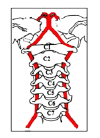Decreased Vertebral Artery Hemodynamics in Patients with Loss of Cervical Lordosis
- PMID: 26876295
- PMCID: PMC4756865
- DOI: 10.12659/msm.897500
Decreased Vertebral Artery Hemodynamics in Patients with Loss of Cervical Lordosis
Abstract
BACKGROUND Because loss of cervical lordosis leads to disrupted biomechanics, the natural lordotic curvature is considered to be an ideal posture for the cervical spine. The vertebral arteries proceed in the transverse foramen of each cervical vertebra. Considering that the vertebral arteries travel in close anatomical relationship to the cervical spine, we speculated that the loss of cervical lordosis may affect vertebral artery hemodynamics. The aim of this study was to compare the vertebral artery values between subjects with and without loss of cervical lordosis. MATERIAL AND METHODS Thirty patients with loss of cervical lordosis and 30 controls matched for age, sex, and body mass index were included in the study. Sixty vertebral arteries in patients with loss of cervical lordosis and 60 in controls without loss of cervical lordosis were evaluated by Doppler ultrasonography. Vertebral artery hemodynamics, including lumen diameter, flow volume, peak systolic velocity, end-diastolic velocity, and resistive index, were measured, and determined values were statistically compared between the patient and the control groups. RESULTS The means of diameter (p=0.003), flow volume (p=0.002), and peak systolic velocity (p=0.014) in patients were significantly lower as compared to controls. However, there was no significant difference between the 2 groups in terms of the end-diastolic velocity (p=0.276) and resistive index (p=0.536) parameters. CONCLUSIONS The present study revealed a significant association between loss of cervical lordosis and decreased vertebral artery hemodynamics, including diameter, flow volume, and peak systolic velocity. Further studies are required to confirm these findings and to investigate their possible clinical implications.
Figures




Similar articles
-
Changes in Vertebral Artery Blood Flow in Different Head Positions and Post-Cervical Manipulative Therapy.J Manipulative Physiol Ther. 2020 Feb;43(2):144-151. doi: 10.1016/j.jmpt.2019.09.001. Epub 2020 May 30. J Manipulative Physiol Ther. 2020. PMID: 32482436
-
The Hemodynamic Response of the Vertebral Artery to 3 Time Durations of the Static Stretching Exercise in the End Position of Contralateral Cervical Rotation.J Manipulative Physiol Ther. 2020 Feb;43(2):152-159. doi: 10.1016/j.jmpt.2019.04.005. Epub 2020 May 30. J Manipulative Physiol Ther. 2020. PMID: 32482435
-
Doppler ultrasound criteria of physiological flow in asymmetrical vertebral arteries.Med Sci Monit. 2007 May;13 Suppl 1:73-7. Med Sci Monit. 2007. PMID: 17507889
-
Doppler Sonography of Blood Flow Velocity in the Vertebral Arteries of Preterm and Term Neonates.J Ultrasound Med. 2016 Sep;35(9):1941-7. doi: 10.7863/ultra.15.09061. Epub 2016 Jul 27. J Ultrasound Med. 2016. PMID: 27466260
-
Effects of Head and Neck Positions on Blood Flow in the Vertebral, Internal Carotid, and Intracranial Arteries: A Systematic Review.J Orthop Sports Phys Ther. 2019 Oct;49(10):688-697. doi: 10.2519/jospt.2019.8578. Epub 2019 Jul 5. J Orthop Sports Phys Ther. 2019. PMID: 31276624
Cited by
-
Does Forward Head Posture Influence Somatosensory Evoked Potentials and Somatosensory Processing in Asymptomatic Young Adults?J Clin Med. 2023 Apr 29;12(9):3217. doi: 10.3390/jcm12093217. J Clin Med. 2023. PMID: 37176657 Free PMC article.
-
Documenting Cervical Spine Injuries Following Negative MRI Findings: Clinical and Medico-Legal Overview of Dynamic Imaging.Cureus. 2025 Jul 16;17(7):e88121. doi: 10.7759/cureus.88121. eCollection 2025 Jul. Cureus. 2025. PMID: 40687407 Free PMC article. Review.
-
Post-concussion syndrome and concussion incidence improved in a pro rugby player following cervical spine rehab: case study and 6-year follow-up.Concussion. 2023 May 4;8(3):CNC107. doi: 10.2217/cnc-2023-0004. eCollection 2023 Apr. Concussion. 2023. PMID: 37691851 Free PMC article.
-
Vertebral Body Sliding Osteotomy for Cervical Myelopathy With Rigid Kyphosis.Neurospine. 2020 Sep;17(3):640-647. doi: 10.14245/ns.2040482.241. Epub 2020 Sep 30. Neurospine. 2020. PMID: 33022167 Free PMC article.
-
Effect of Forward Head Posture on Resting State Brain Function.Healthcare (Basel). 2024 Jun 7;12(12):1162. doi: 10.3390/healthcare12121162. Healthcare (Basel). 2024. PMID: 38921277 Free PMC article.
References
-
- Tan LA, Straus DC, Traynelis VC. Cervical interfacet spacers and maintenance of cervical lordosis. J Neurosurg Spine. 2015;22(5):466–69. - PubMed
-
- McAviney J, Schulz D, Bock R, et al. Determining the relationship between cervical lordosis and neck complaints. J Manipulative Physiol Ther. 2005;28(3):187–93. - PubMed
-
- Cacciola F, Phalke U, Goel A. Vertebral artery in relationship to C1–C2 vertebrae: an anatomical study. Neurol India. 2004;52(2):178–84. - PubMed
MeSH terms
LinkOut - more resources
Full Text Sources

